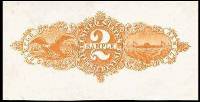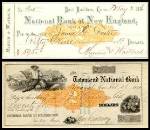
|
<<<< |

|
>>>> |

|

TRAINS ON U. S. STAMPS
and POSTAL STATIONERY
page 1
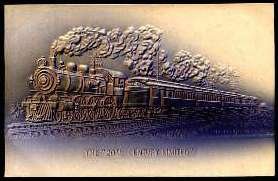
Embossed postcard with train image - 20th Century Limited |
|
Trains on stamps are my favorite collecting area, so although these pages are not formally a part of our philatelic alphabet, I am including them so I can share some of my favorite stamps and covers.
Below and on the following pages are all the U.S. stamps and postal stationery with a
train, as listed in ATA Handbook 138, World Railways Philatelic, by Norman E. Wright, Sr.
(to which I am indebted for much of the technical data quoted here).
(Click on any image to see a higher-resolution version.)
|
1869 Issue - 3¢ Locomotive - Issued March, 1869 - Scott 114
|
||||||||||

Sc. 114 - 3¢ ultramarine - issued March 27, 1869 SC. 125 - issued 1875 |

Essay for Sc. 114
|
The locomotive shown on this stamp is a classic 4-4-0 of the period. It was probably a wood-burner, which is suggested by the flared shape of its smokestack, but I say that also because most early U.S locomotives burned wood, which was so plentiful in this country then.
One of the things I like about essays is that they are always top-quality impressions of the stamp design - no plate wear or under-inking - and perfectly centered, so one gets to see the design in its ideal state - compare the closeups (click on each image) of the two items above, and you'll see what I mean - the stamp (on the left) is a fantastic copy for this issue, but the clarity and detail on the essay (on the right) are still far better.
An essay does not have the same design as the final stamp, of course, it is an earlier version, differing in some significant way from the final version. Here the most noticeable difference is the numeral "3" at the bottom, and the framing of it, but the central vignette is the same.
The stamp was printed by the National Bank Note Company, under a contract they won through competitive bidding in 1868 (the BEP did not start printing US stamps until 1894). National had printed all US stamps since 1861. The designer was James Macdonough, and the engravers were George W Thurber (frame and lettering) and Christian Rost (vignette). (Click here for a biography of Christian Rost by a modern admirer of his work.)
There are many varieties of Scott 114. Its Scott US Specialized Catalogue listing is fully half a column in length. The stamps were issued with grills, of which there are several varieties. In addition there are several recognized color varieties, plus plate, production, and position varieties, making it an interesting stamp for the specialist. Scott even lists a trisect and a double trisect, both on cover.
Since this stamp was distributed in fairly large quantities - over 300 Million copies - it is relatively affordable used, cataloguing $10, whereas a decent unused copy, sans gum, catalogues at $100. There are even several full sheets of 150 still in existence.
Since there was no official date of issue for stamps at the time, there is no such thing as a First Day Cover for this stamp. Moreover, even once the new stamps had been distributed, postmasters were instructed not to sell the new stamps until they had exhausted their supplies of the old. So while some denominatiouns of this issue were distributed in mid-March, and some cite an issue date for Scott 114 of March 19, the Earliest Known Use (EKU) for this stamp currently stands at March 29, 1869.
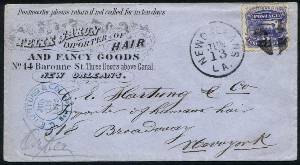
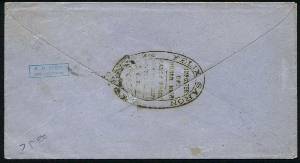
Scott 114 on advertising cover, postmarked June 13, 1870 |
Cover collectors seek Scott 114 on political or advertising covers, with fancy cancels, with unusual postal markings , and to foreign destinations. Covers with none of these distinctions can be purchased for $10 apiece, while the more desirable ones can fetch hundreds of dollars. I paid $75 for the one above, a clean, attractive advertising cover with a well-centered stamp, a clear cancel, and a clear receiving stamp. A date closer to the stamp's issue date would make this cover more valuable.
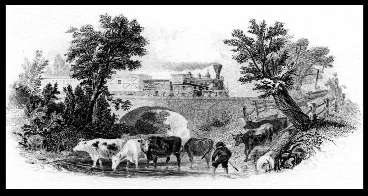
The Crossing, NBNC engraving ca. 1869 from ABNC souvenir card, 8/22/91 |
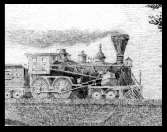
Closeup, source engraving for Scott 0114 locomotive
|
The central train vignette of this stamp was based on similar engravings used by the National Bank Note Company on currency of the period. (It was common practice for engravers to recycle images in this way - creating new master dies from scratch was a costly, laborious, time-consuming process.) The NBNC image on the left above, entitled The Crossing, is usually cited as the most likely source for this stamp's train image. It was engraved by James Smillie, one of the most prolific and respected engravers of the period. As one can see from the enlargement on the right, the designs, while not exact duplicates, are indeed very close, certainly sufficiently so to say it is the same locomotive. Below is an example of a bank note using that image
(If anyone can send me further details about this locomotive, I would welcome them.)
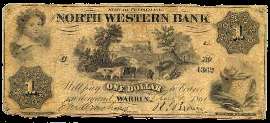
Bank Note - 1861 with "The Crossing" |
Recently I ran across the stock certificate below on the www, and purchased it, thinking it was another example of Smillie's engraving, but when I got it and looked closely, realized it is quite different, though based on the earlier image. There are no animals in the foreground, the locomotive and cars are different, etc., yet the bridge is the same, and the compositions are too similar for it to be coincidence. I presume the artist modified the older design to fit the new use, substituting a train that actually belonged to the Flint & Pere Marquette. That RR was founded in 1857, which could be the date of this certificate, but the vignette was used for several decades, so it could be as late as 1890.
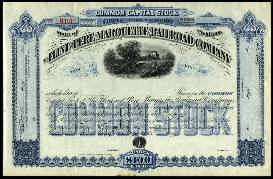
Stock Certificate - 1857 (or later) |
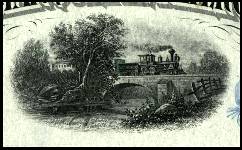
Detail of vignette |
The 3-cent locomotive stamp was the workhorse (it paid the basic domestic letter rate, 3¢ per half oz) of the group of stamps shown below, the 1869 Issue, Scott 112-122. These were the first pictorial stamps of the US, i.e., the first showing something other than portraits of famous leaders, and they are regarded by many as the first commemorative issue, since they depict historical events. The selection of a train for the 3-cent value was presumably related to the completion of the first trans-continental railroad in the same year these stamps were issued.
U.S. Pictorials Issue of 1869
|
Though almost universally admired now, these stamps were not popular at the time, for almost every reason imaginable - gum, color, shape, size, designs - little about them seemed satisfactory to the public. Perhaps they were too abrupt a change from the prior style. Stamp production was still somewhat in its infancy (the first US stamp had been issued only 22 years earlier, in 1847), so production quality was definitely an issue, and it is difficult to find a well-centered, well- printed example of the lower values of the series.
There was a special printing of this series in 1875, in conjunction with the Centennial International Exposition of 1876 in Philadelphia, to enable the USPOD to mount a display of all US stamp issues to that time - no one had thought to keep any. The reprints were sold to collectors as well, but were issued in such miniscule quantities - a mere 1,406(!) of the 3-cent value, that they are accessible now only to the wealthiest of collectors. The 3-cent value is Scott 125, and catalogs $3,150 for a clean unused copy with no gum.
SECOND AND THIRD ISSUE REVENUE STAMPS
|
||
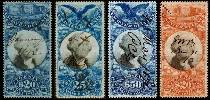
Sc. R129, 130, 131, 150 - issued 1871 and 1872 |
I'm pretty sure there is a train in there, but you can be forgiven if you can't find it, even in the high-res version of my scan (click on thumbnail above). It's in the tiny picture immediately to the left of and above George's portrait, in front of the building with the tall smokestack. There is smoke coming from the locomotive. Honest, it's there.
These are not cheap stamps: R129 catalogs $400, R130 catalogs $450, R131 catalogs $450, and R150 catalogs $525. That adds up to a lot more than I care to spend for a train that can't be seen without a microscope. I settled for a damaged but nice-looking copy of R150 as a representative of all four.
This illustrates one of the dilemmas of thematic collecting - do I want EVERYTHING my fellow collectors have decided qualifies, or do I want only the ones that appeal to me? I admit I am not always consistent, but generally I skip the ones where I can't see a locomotive with my naked eye, especially if they're expensive.
Revenue stamps are tax stamps, as you might guess from that "U.S.INTERN.REVENUE" inscription, used to record the payment of taxes on such things as the transfer of property. They were affixed to the transfer document and cancelled with a pen. They are also Cinderellas, of course.
If you have looked at the pages of my main exhibit, the philatelic alphabet, you may recognize the central vignette of this stamp as identical with those on the Large and Small Persian Rugs, and indeed, this design was part of the same series as those more famous products. They were all part of the U.S. government's obsession during this period with prevention of counterfeiting and re-use of its stamps. An entire set of elaborate new designs was created for Revenue stamps, and printed on special papers that absorbed cancels more readily and with special inks that faded or changed color when subjected to washing or cleaning.
US TRAINS
|
Send feedback to the webmaster: CLICK HERE
Revised -- 12/09/2004










